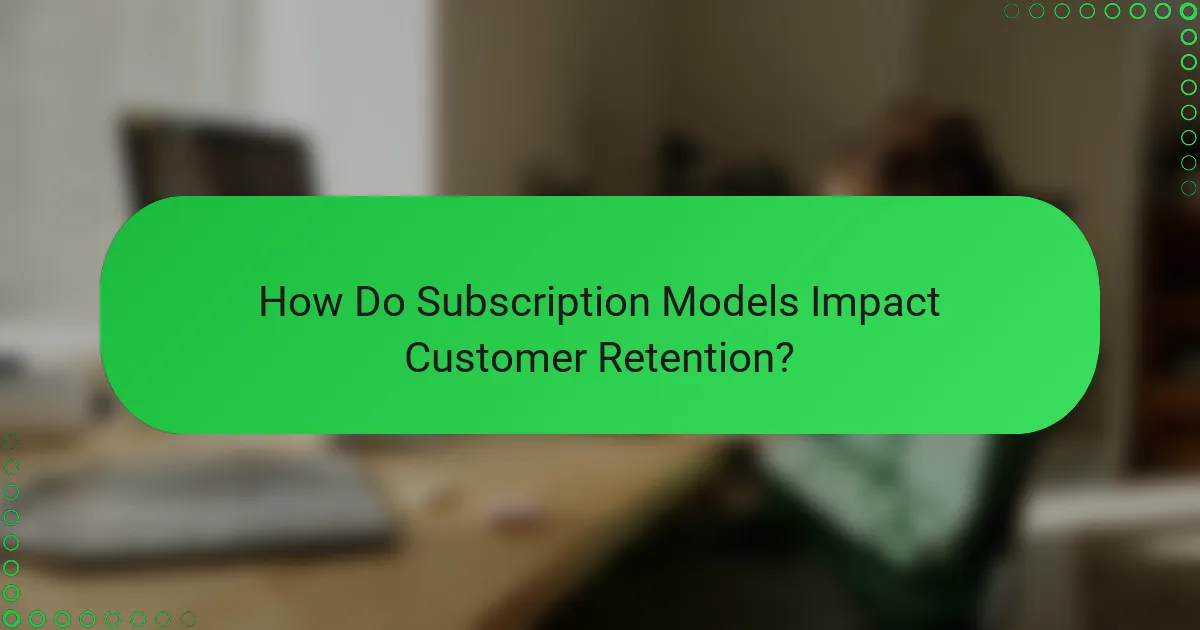Subscription models are evolving rapidly, shaped by consumer preferences and technological advancements. As businesses adapt to these changes, they are increasingly focusing on personalized experiences and innovative pricing strategies that resonate with users. The future promises a shift towards enhanced engagement and community-driven offerings, making it crucial for providers to stay attuned to emerging trends.

What Are the Key Subscription Models for Online Courses?
Key subscription models for online courses include various payment structures that cater to different consumer preferences and learning needs. These models can significantly influence user engagement and retention, making it essential for providers to choose the right approach.
Monthly subscriptions
Monthly subscriptions allow users to pay a set fee each month for access to course materials. This model is appealing for learners who prefer flexibility and want to explore various courses without a long-term commitment.
Providers should consider offering a trial period to attract new users. Common pricing ranges from $10 to $50 per month, depending on the course quality and content depth.
Annual subscriptions
Annual subscriptions require users to pay a lump sum for a full year of access, often at a discounted rate compared to monthly payments. This model benefits both users and providers, as it encourages long-term commitment and reduces churn rates.
Typical annual fees range from $100 to $500, depending on the platform and course offerings. Offering incentives, like exclusive content or early access to new courses, can enhance the appeal of annual subscriptions.
Freemium models
Freemium models provide basic course access for free while charging for premium features or advanced courses. This approach attracts a wide audience and allows users to sample content before committing financially.
To maximize conversion rates, providers should focus on showcasing the value of premium offerings. Common strategies include offering additional resources, personalized feedback, or certification for paid users.
Pay-per-course
Pay-per-course models charge users for individual courses rather than a subscription. This option is suitable for learners who prefer to pay only for specific content they are interested in, without ongoing costs.
Course prices can vary widely, typically ranging from $20 to $500, depending on the course complexity and duration. This model can be attractive for users who want to learn at their own pace without a subscription commitment.
Membership tiers
Membership tiers offer different levels of access and benefits based on the subscription price. This model allows learners to choose a plan that best fits their needs and budget, providing options for casual learners and serious students alike.
Common tiers might include basic access, premium content, and one-on-one mentoring. Pricing can range from $15 to $100 per month, with higher tiers offering more extensive resources and support. This flexibility can enhance user satisfaction and loyalty.

How Do Consumer Preferences Shape Subscription Pricing?
Consumer preferences significantly influence subscription pricing by determining what features and benefits are valued most. As businesses adapt to these preferences, they often implement pricing strategies that align closely with consumer expectations and perceived value.
Value-based pricing strategies
Value-based pricing strategies focus on setting subscription prices based on the perceived value to the consumer rather than the cost of the service. This approach requires businesses to understand their target audience’s needs and how much they are willing to pay for specific features or benefits.
For example, a streaming service might charge more for exclusive content that consumers highly value, while offering basic access at a lower price. This strategy can lead to higher customer satisfaction and retention when consumers feel they are receiving good value for their money.
Discounts for long-term commitments
Offering discounts for long-term commitments is a common tactic to encourage consumers to subscribe for extended periods. This pricing model typically provides a lower monthly rate for users who pay upfront for a year or more, making it financially attractive.
For instance, a software subscription might cost $10 per month on a month-to-month basis, but only $8 per month if paid annually. This not only increases customer loyalty but also helps businesses secure predictable revenue streams.
Personalized pricing options
Personalized pricing options cater to individual consumer preferences by allowing for tailored subscription plans. This can include customizable features, usage-based pricing, or tiered plans that adjust based on user behavior and needs.
For example, a fitness app might offer different subscription levels based on how often a user engages with the app, providing incentives for higher engagement. This flexibility can enhance user satisfaction and encourage more consumers to subscribe, as they feel the service is designed specifically for them.

What Are the Future Trends in Subscription Models?
The future of subscription models is leaning towards enhanced personalization, the integration of artificial intelligence in pricing strategies, and a greater emphasis on community engagement. These trends reflect changing consumer preferences and technological advancements that aim to create more tailored and interactive experiences.
Increased personalization
Personalization in subscription models involves tailoring offerings to meet individual consumer preferences and behaviors. Companies are leveraging data analytics to understand customer habits, enabling them to provide customized content, product recommendations, and pricing options.
For example, streaming services often suggest shows based on viewing history, while subscription boxes curate items based on user profiles. This level of personalization can significantly enhance customer satisfaction and retention.
Integration of AI in pricing
Artificial intelligence is increasingly being used to optimize pricing strategies in subscription models. By analyzing consumer data and market trends, AI can help businesses set dynamic pricing that adjusts based on demand, seasonality, and customer behavior.
For instance, a software subscription might offer lower rates during off-peak times or provide discounts for long-term commitments. This approach not only maximizes revenue but also makes pricing more attractive to consumers.
Focus on community engagement
Community engagement is becoming a vital aspect of subscription models, as brands seek to foster loyalty and create a sense of belonging among subscribers. This can be achieved through interactive platforms, forums, and events that encourage user participation and feedback.
Brands like fitness subscriptions often host community challenges or virtual meet-ups, allowing subscribers to connect and share experiences. This engagement not only enhances the value of the subscription but also strengthens brand loyalty and advocacy.

What Criteria Should Be Considered When Choosing a Subscription Model?
When selecting a subscription model, it’s crucial to evaluate the target audience, market competition, and content delivery methods. These factors will help ensure that the chosen model aligns with consumer preferences and market trends.
Target audience analysis
Understanding your target audience is essential for a successful subscription model. Consider demographics such as age, income, and lifestyle, as these factors influence purchasing decisions. For example, younger consumers may prefer lower-cost, flexible plans, while older demographics might value premium offerings with added features.
Conduct surveys or focus groups to gather insights about your audience’s preferences and pain points. This direct feedback can guide your pricing strategy and content offerings, ensuring they resonate with potential subscribers.
Market competition assessment
Analyzing the competitive landscape is vital when choosing a subscription model. Identify key competitors and their offerings to understand market standards and pricing strategies. This analysis will help you position your subscription model effectively, whether you aim to compete on price, quality, or unique features.
Consider using a SWOT analysis (Strengths, Weaknesses, Opportunities, Threats) to evaluate your position relative to competitors. This structured approach can reveal gaps in the market that your subscription model can fill, providing a competitive edge.
Content delivery methods
The method of content delivery significantly impacts subscriber satisfaction and retention. Evaluate whether your content will be delivered via streaming, downloads, or physical products, as each method has its pros and cons. For instance, streaming services often attract a younger audience due to convenience, while physical products may appeal to niche markets.
Additionally, consider the technology and platforms required for effective delivery. Ensure that your chosen method aligns with consumer preferences and is scalable as your subscriber base grows. Regularly assess feedback to adapt your delivery methods to changing consumer expectations.

How Do Subscription Models Impact Customer Retention?
Subscription models significantly enhance customer retention by creating ongoing engagement and loyalty. These models foster a sense of belonging and convenience, encouraging customers to remain committed to a brand over time.
Understanding Customer Loyalty in Subscription Services
Customer loyalty in subscription services is built through consistent value delivery and personalized experiences. Subscribers often feel more connected to brands that cater to their preferences and provide regular updates or exclusive content. This emotional bond can lead to longer retention periods compared to traditional purchasing models.
Key Factors Influencing Retention Rates
Several factors influence retention rates in subscription models, including pricing, service quality, and customer support. Competitive pricing strategies can attract new subscribers, but maintaining value is crucial for keeping them. Additionally, responsive customer support can resolve issues quickly, enhancing overall satisfaction.
Strategies to Improve Retention
To improve retention, companies should focus on delivering exceptional customer experiences. Regularly soliciting feedback can help identify areas for improvement. Implementing loyalty programs or offering personalized discounts can also incentivize subscribers to stay engaged.
Common Pitfalls to Avoid
One common pitfall is neglecting existing subscribers in favor of acquiring new ones. This can lead to dissatisfaction among current customers. Additionally, failing to communicate changes in pricing or service can result in churn, as subscribers may feel blindsided by unexpected alterations.
